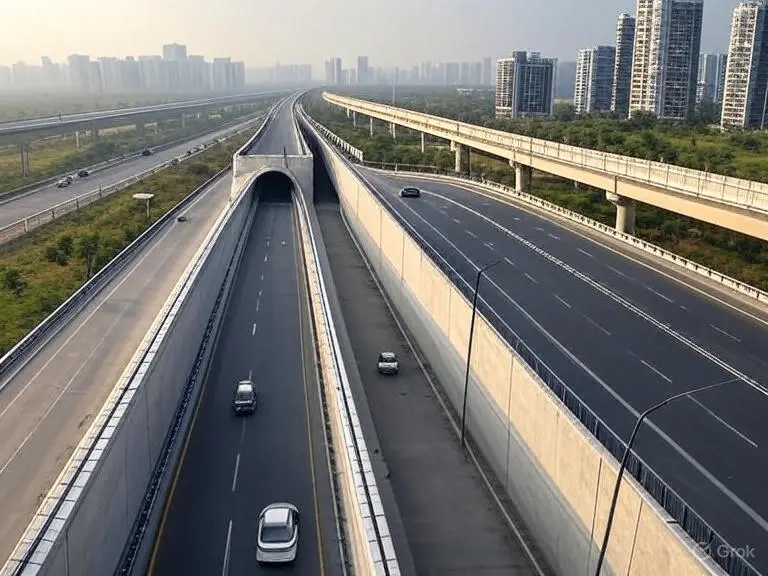New Delhi – Union Road Transport and Highways Minister Nitin Gadkari has announced an infrastructure plan to reduce the commute time between Delhi-Gurgaon to just 30 minutes, offering relief to millions of daily commuters in the National Capital Region (NCR). The proposal, which includes a high-speed corridor and a tunnel network, aims to address the chronic traffic congestion on National Highway 48 (NH-48).

Table of Contents
A High-Speed Corridor to Revolutionize Commuting
The plan features a high-speed corridor designed to cut the current hour-long journey between Delhi and Gurgaon to approximately 25–30 minutes. The corridor will start from either Talkatora Stadium or Gyarah Murti in Central Delhi, covering about 30 kilometers to Gurgaon. This route will bypass congested areas, ensuring a smoother commuting experience. Additionally, an elevated corridor is proposed to connect the Delhi-Meerut Expressway to the AIIMS-Mahipalpur Bypass, reducing traffic bottlenecks on roads like Ring Road and Mehrauli-Gurgaon Road. The National Highways Authority of India (NHAI) is evaluating these proposals, with bids invited for preparing the Detailed Project Report (DPR).
Tunnel to IGI Airport and Dwarka Expressway
A key component is a 5-kilometer tunnel linking the Delhi-Gurgaon corridor to the Indira Gandhi International (IGI) Airport and the Dwarka Expressway. Estimated to cost ₹3,500 crore, this tunnel will provide an alternative to NH-48, easing congestion at critical junctions like Shiv Murti Chowk, where traffic from Dwarka Expressway, Kapashera, and NH-48 converges. The tunnel is expected to reduce travel time from Shiv Murti to Nelson Mandela Marg to 7–8 minutes, compared to the current hour during peak hours.
Also Read: Delhi Cabinet Approves ₹53 Crore for Local Development Projects Across Districts
Broader Infrastructure Overhaul for NCR
The announcement is part of a ₹12,500 crore initiative to alleviate traffic congestion and air pollution in Delhi and surrounding areas. Other projects include a 17-kilometer link connecting Urban Extension Road (UER-II) at Alipur with the Delhi-Dehradun Expressway at Tronica City in Ghaziabad (₹2,200 crore) and a 35-kilometer link from the Delhi-Dehradun Expressway to Noida (₹4,400 crore), serving as a bypass for East Delhi. These projects aim to divert traffic from Haryana and Rajasthan, reducing the strain on Delhi’s road network.
Over the past decade, 55,000 kilometers of national highways have been constructed, including the Delhi-Meerut Expressway, which reduced travel time to Meerut to 45 minutes, and the Delhi-Mumbai Expressway, cutting travel time to 12 hours.
Addressing Delhi’s Pollution Crisis
The plan is expected to help reduce Delhi’s air pollution by diverting heavy vehicles and easing congestion, thereby lowering vehicular emissions. In December 2024, Gadkari proposed transitioning to CNG-powered transportation as a complementary measure to address the capital’s pollution crisis.
Challenges and Next Steps
Challenges include land acquisition and coordination between agencies like the NHAI, Gurugram Metropolitan Development Authority (GMDA), and Delhi’s Public Works Department (PWD). A previous proposal for a cloverleaf structure at Vatika Chowk to connect the Southern Peripheral Road (SPR) with the Delhi-Mumbai Expressway was abandoned due to spatial constraints, highlighting potential obstacles.
The NHAI is conducting feasibility studies for the tunnel and elevated corridors, focusing on integration with existing expressways like the Delhi-Meerut and Delhi-Mumbai Expressways. The completion of the DND-Sohna spur of the Delhi-Mumbai Expressway by the end of 2025 is expected to increase traffic through Central Delhi, making these new links essential.
Public Response
The announcement has sparked interest on social media, with posts on X describing the 30-minute Delhi-Gurgaon commute as a potential game-changer for NCR commuters. As feasibility studies and DPRs progress, residents are hopeful for relief from the region’s notorious traffic congestion.
Sources: The Economic Times, The Financial Express, The Times of India, and posts on X.
